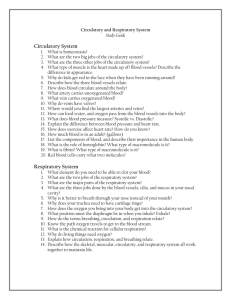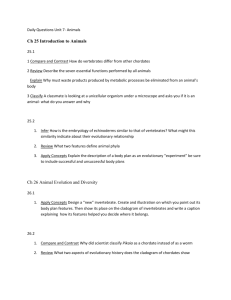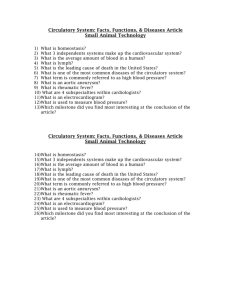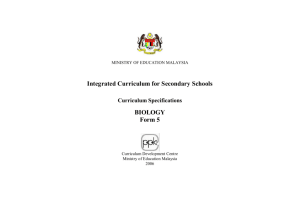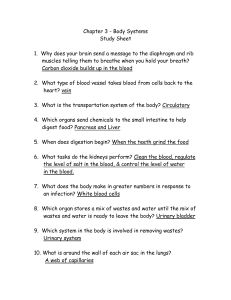THE MALAY COLLEGE KUALA KANGSAR COURSE OF STUDY
advertisement
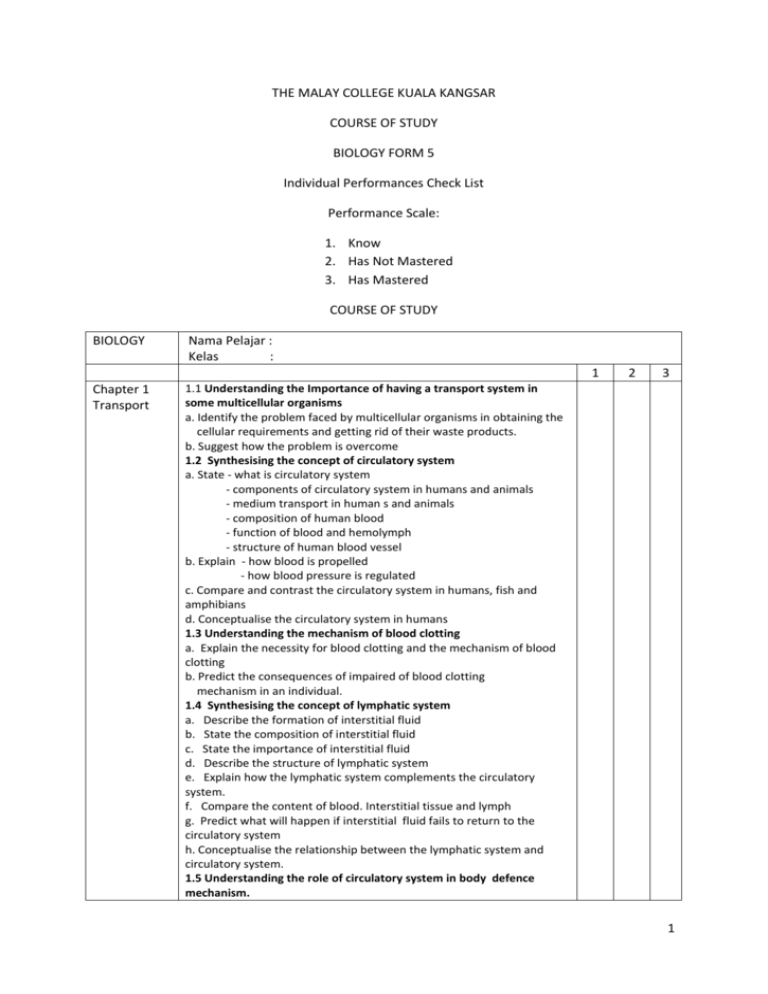
THE MALAY COLLEGE KUALA KANGSAR COURSE OF STUDY BIOLOGY FORM 5 Individual Performances Check List Performance Scale: 1. Know 2. Has Not Mastered 3. Has Mastered COURSE OF STUDY BIOLOGY Nama Pelajar : Kelas : 1 Chapter 1 Transport 2 3 1.1 Understanding the Importance of having a transport system in some multicellular organisms a. Identify the problem faced by multicellular organisms in obtaining the cellular requirements and getting rid of their waste products. b. Suggest how the problem is overcome 1.2 Synthesising the concept of circulatory system a. State - what is circulatory system - components of circulatory system in humans and animals - medium transport in human s and animals - composition of human blood - function of blood and hemolymph - structure of human blood vessel b. Explain - how blood is propelled - how blood pressure is regulated c. Compare and contrast the circulatory system in humans, fish and amphibians d. Conceptualise the circulatory system in humans 1.3 Understanding the mechanism of blood clotting a. Explain the necessity for blood clotting and the mechanism of blood clotting b. Predict the consequences of impaired of blood clotting mechanism in an individual. 1.4 Synthesising the concept of lymphatic system a. Describe the formation of interstitial fluid b. State the composition of interstitial fluid c. State the importance of interstitial fluid d. Describe the structure of lymphatic system e. Explain how the lymphatic system complements the circulatory system. f. Compare the content of blood. Interstitial tissue and lymph g. Predict what will happen if interstitial fluid fails to return to the circulatory system h. Conceptualise the relationship between the lymphatic system and circulatory system. 1.5 Understanding the role of circulatory system in body defence mechanism. 1 Chapter 2 Locomotion and Support Chapter 3 Coordination and Response a. State the three lines of defence mechanism of the body b. Describe the process of phagocytosis c. State – the meaning of antigen ,antibody, immunity, immunisation - the effects of human immunodeficiency virus( HIV) on the body’s defence mechanism d. Suggest ways to prevent the spread of AIDS 1.6 Appreciating a healthy cardiovascular system 1.7 Understanding the transport of substances in plants a. Identify and describe the structure of the vascular tissue in stem, root and leaf and relate with their function. b. Predict the effect of removing a ring of phloem to transport. 1.8 Synthesising the concept of transport of substances in plants a. Explain the importance of translocation and transpiration b. Describe the process of translocation and transpiration c. Describe the pathway of water to the soil to the leaves d. Design an experiments to study factors affecting the rate of transpiration e. Conceptualise the transport mechanism in plants 2.1 Understanding support and locomotion in human and animals a. Explain the necessity for support and locomotion b. Describe the problems that could be faced in support and locomotion and how to overcome the problems c. Identify, name and label the bones, tendons, ligaments , muscles and joints . d. Explain how movement is brought in limb e. State the function of cartilage and synovial fluid at joints f. Describe briefly the mechanism of locomotion in an animal g. State some consequences of impaired musculoskeletal system on support and locomotion. 2.2 Appreciating a healthy musculoskeletal system a. Practice ways to care for the musculoskeletal system. 2.3 Understanding support in plants a. Explain the necessity for support in plants b. Explain how support is achieved in aquatic plants c. Explain how support in terrestrial plants are achieved through tissue modifications. 3.1 Understanding response and coordination a. List the changes in external and internal environment faced by an organism b. State why organism have to be sensitive to changes in internal and external environment c. Clarify through examples the meaning of coordination , stimulus and response d. State the main components and pathways involved in detecting and responding to changes in external and internal environment. 3.2 Analysing the role of human nervous system a. State the role of nervous system b. Draw and label diagram to show the organisation of the nervous system and cross section of spinal cord c. Name the main part of the brain and state their functions d. Identify and label the structure of neurone e. State the function of different type of neurone f. Describe the mode of transmission of information along the neurone g. Describe the pathway of transmission of information from receptors to effectors 2 Chapter 4 Reproduction and Growth h. Draw and label diagram of synapse i. Describe the transmission of information across synapse j. Give examples of voluntary and involuntary action k. Outline the transmission of voluntary and involuntary action. l. Draw a schematic diagram showing a reflex arc m. Give examples of nervous system related diseases. 3.3 Analysing the role of hormones in humans a. State : - what a hormone is - what the endocrine system is - why the endocrine system is necessary b. Label the main glands of the endocrine system and name the hormones produced by the glands c. Describe how the endocrine system complements the nervous system d. State the function of the hormones involved in some physiological processes e. Describe briefly how secretion of hormone is regulated f. Describe briefly the “fight” and “flight” situation. g. State the effects of hormonal imbalance h. State the use of hormone in medicine 3.4 Synthesising the concept of homeostasis in humans a. Explain the necessity to maintain an optimal physical and chemical condition in the internal environment b. State the meaning of homeostasis c. Design an experiment to study the effect of different quantities of water intake on urine output d. Relate changes in blood osmotic pressure to urine output e. Describe the formation of urine f. Relate the formation of urine to excretion g. Describe briefly the mechanism of osmoregulation h. Predict the consequences of impaired kidney function i. Describe the regulation of blood sugar level j. Describe the regulation of body temperature k. Conceptualise homeostasis 3.5 Practising a healthy lifestyle a. describe effects of drug and alcohol abuse on humans b. explain the factors that can lead to drug and alcohol abuse c. practise a healthy lifestyle 3.6 Understanding plant hormones a. state what plant hormones are b. give some examples of plant hormones c. infer the effects of auxins on growth responses d. explain the role of auxins in tropism e. state the use of hormones in agriculture 4.1 Analysing gamete formation a. explain the necessity for organisms to reproduce b. state types of reproduction c. explain the necessity for formation of gametes d. describe formation of sperm in humans e. describe formation of ovum in humans f. compare the formation of sperm with that of ovum 4.2 Analysing the role of hormones in the menstrual cycle a. State what menstruation is b. Relate menstruation to menstrual cycle c. State the importance of the menstrual cycle d. State the hormones involved in the menstrual cycle e. Explain the role of hormones in regulating the menstrual cycle 3 f. Chapter 5 Inheritance Relate hormonal levels to the development of follicles , the process of ovulation and the formation of corpus luteum g. Relate hormonal levels to the changes in thickness of the endometrium h. State what premenstrual syndrome (PMS) is i. State what menopause is 4.3 Understanding the early development of a zygote in humans a. Describe what fertilisation is b. Describe in simple terms the early development of a zygote c. Name the two main stages in the development of a zygote in preparation for implantation d. Describe the formation of twins e. Compare identical twins with fraternal twins f. State the functions of the placenta in foetal development g. Explain the advantages of fetus having a separate circulatory system from that of the mother 4.4 Appreciating the contribution of science and technology to human reproduction a. Explain the contribution of science and technology to human reproduction b. Explain some moral issues related to the application of science and technology to human reproduction c. What sexually transmitted diseases are d. Give examples of sexually transmitted diseases 4.5 Synthesising the concept of sexual reproduction in flowering plants a. Identify male and female structures in a flower b. Describe the formation of pollen grains c. Describe the formation of the embryo sac in the ovule d. Describe the formation of pollen tube e. Describe the formation of zygote f. Describe the formation of triploid nucleus g. Conceptualise double fertilisation h. Relate the structure of a fruit to the flower parts i. Explain the importance of double fertilisation for the survival of flowering plants 4.6 Understanding growth in multicellular organisms a. Explain briefly the necessity for growth in organisms b. Explain what growth is 4.7 Understanding the growth curve a. Identify the parameters used in the measurement of growth b. Describe the sigmoid growth curve of an organism c. Relate the shape of the growth curve to the growth phases of an organism d. Explain the shape of the growth curve of an insect 4.8 Understanding primary and secondary growth in plants a. State the types of growth in plants b. State what primary and secondary growth are c. Name the tissue involved in primary and secondary growth d. Explain the importance of primary growth e. Explain the importance of secondary growth f. Compare and contrast plants that undergo secondary growth with plans that do not undergo secondary growth g. State the economic importance of plants that undergo secondary growth 5.1 Synthesising the concept of inheritance based on Mendel’s experiment a. State what is meant by inheritance 4 b. c. d. Chapter 6 Variation Differentiate traits from characters Identify characters and traits in Mendel’s experiments State that there is a hereditary factor that determines a particular character e. Identify dominant and recessive traits f. Explain genes and alleles g. Explain dominant alleles and recessive alleles h. State the meaning of phenotype i. State the meaning of genotype j. Relate allele combination to genotype k. Relate phenotype to genotype l. State the meaning of homozygote and heterozygote m. Determine the phenotypic ratio of the first filial generation and second filial generation n. Determine the genotypic ratio of the first filial generation and second filial generation o. State the meaning of monohybrid inheritance p. Conceptualise Mendel’s First Law q. State the meaning of ‘dihybrid inheritance’ r. Conceptualise Mendel’s Second Law 5.2 Understanding inheritance a. State the blood groups in the ABO system and Rhesus factor in humans b. Explain the inheritance of ABO blood group in humans c. Differentiate autosomes from sex chromosomes d. Identify the different human karyotypes e. Explain sex determination in off-springs f. Explain sex-linked inheritance using examlples g. Describe hereditary disease 5.3 Understanding genes and chromosomes a. State the unit of inheritance b. State the location of genes c. Describe the structure of deoxyribonucleic acid (DNA) d. Describe in simple terms the manifestation of a trait of an organism from the basic unit of inheritance e. Explain briefly the importance of genetics to mankind f. Describe the application and abuse of knowledge in genetics g. Argue on the need for ethics and moral in the application of genetics 6.1 Understanding variation in organisms a. State the importance of variation in organisms b. Give examples of variation in humans c. State the types of variation d. Compare continuous variation with discontinuous variation. 6.2 Understanding the causes of variation a. State the factors causing variation b. Explain the effects of genetic factors on variation c. Explain the effects of environmental factors on variation d. Explain the effects of the interaction between genetic factors and environmental factors in variation e. Explain mutation f. Explain the importance of variation in the survival of a species 6.3 Be respectful towards one another despite variation a. Accept that people are different b. Respect each other 5 6
